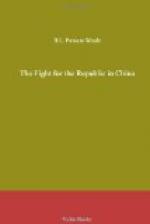Here another word of explanation is necessary to show clearly the precise meaning of regionalism in China.
What had originally created each province was the chief city in each region, such cities necessarily being the walled repositories of all increment. Greedy of territory to enhance their wealth, and jealous of their power, these provincial capitals throughout the ages had left no stone unturned to extend their influence in every possible direction and bring under their economic control as much land as possible, a fact which is abundantly proved by the highly diversified system of weights and measures throughout the land deliberately drawn-up to serve as economic barriers. River-courses, mountain-ranges, climate and soil, no doubt assisted in governing this expansion, but commercial and financial greed was the principal force. Of this we have an exceedingly interesting and conclusive illustration in the struggle still proceeding between the three Manchurian provinces, Fengtien, Kirin and Heilungchiang, to seize the lion’s share of the virgin land of Eastern Inner Mongolia which has an “open frontier” of rolling prairies. Having the strongest provincial capital—Moukden—it has been Fengtien province which has encroached on the Mongolian grasslands to such an extent that its jurisdiction to-day envelops the entire western flank of Kirin province (as can be seen in the latest Chinese maps) in the form of a salamander, effectively preventing the latter province from controlling territory that geographically belongs to it. In the same way in the land-settlement which is still going on the Mongolian plateau immediately above Peking, much of what should be Shansi territory has been added to the metropolitan province of Chihli. Though adjustments of provincial boundaries have been summarily made in times past, in the main the considerations we have indicated have been the dominant factors in determining the area of each unit.
Now in many provinces where settlement is age-old, the regionalism which results from great distances and bad communications has been greatly increased by race-admixture. Canton province, which was largely settled by Chinese adventurers sailing down the coast from the Yangtsze and intermarrying with Annamese and the older autochthonous races, has a population-mass possessing very distinct characteristics, which sharply conflict with Northern traits. Fuhkien province is not only as diversified but speaks a dialect which is virtually a foreign language. And so on North and West of the Yangtsze it is the same story, temperamental differences of the highest political importance being everywhere in evidence and leading to perpetual bickerings and jealousies. For although Chinese civilization resembles in one great particular the Mahommedan religion, in that it accepts without question all adherents irrespective of racial origin, politically the effect of this regionalism has been such that up to very recent times the Central Government has been almost as much a foreign government in the eyes of many provinces as the government of Japan. Money alone formed the bond of union; so long as questions of taxation were not involved, Peking was as far removed from daily life as the planet Mars.




